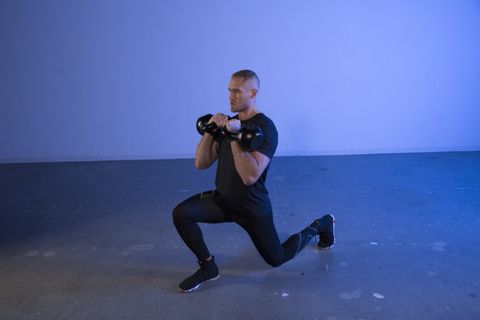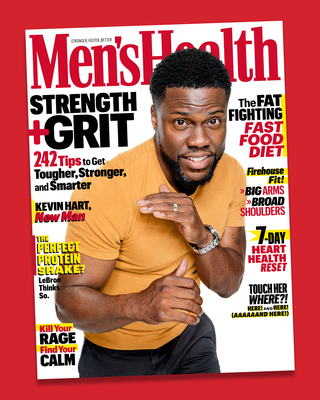
The kettlebell front rack can be a game-changing position that can add an extra element to your workouts, but are you sure you’re even holding the weights correctly?
For this grip, you shouldn’t settle for anything other than perfect form—especially because it’s such a killer position. Let Men’s Health fitness director Ebenezer Samuel, C.S.C.S. and associate fitness editor Brett Williams guide you through its subtleties, saving you from the bad habits that are keeping you from unlocking your fitness potential.
Before you grab a kettlebell and swing it up into the rack, take note that it’s extremely important to pay attention to the grip. Using the proper form is essential to make sure you’re getting the most out of the exercises you do—particularly because of how easy it is to hold the bell lazily and put your wrists and shoulders in danger. Let’s break down everything you need to know.

Men’s Health

Men’s Health
Work
Eb says: The key thing to understand about the front rack is that at its core, it’s a position of work. Every muscle in your upper body should be working and firing to help you maintain a proper front rack, from abs keeping ribcage down to forearm muscles fighting the kettlebells to keep your wrists straight, to mid-back muscles working to keep your arms close to your body. It shouldn’t be easy. You should have full-body tension just holding a front rack, let alone doing squats or any other maneuver.
Elbows Tight
Eb says: One of the key mistakes people make with the front rack involves letting their elbows flare out wide. It’s convenient to do this because it makes the rack less strenuous, and it lets you use your upper arms as a sort of “shelf” to sit the kettlebells. But what you actually want to do is squeeze your elbows tight toward your torso; doing this will help you get your forearms vertical.
This will also essentially get your shoulder external rotators firing, another plus. You won’t always have fully vertical forearms, especially once you start using bigger kettlebells. But you always want to think about actively squeezing your elbows together, because it’ll put you in good body position.
Strong Wrists
Eb says: The kettlebells will bend your wrists so they can shift outwards. Actively fight this. Squeeze and grip the kettlebells hard, and work to turn your wrists in as much as possible; this will actively tense your forearms.
That’s a good feeling and habit to develop, and it’ll help you develop forearm strength in this move.
Constantly Check In
Eb says: At the start of each set, you want to work through a checklist for the front rack (strong wrists, tight elbows, pull the arms back to the body), but don’t stop working through that checklist either.
During your set, every few reps, think about resetting your front rack, and reevaluating to make sure you’re owning the rack. The more you do this, the better you’ll get at establishing your front rack, and the more you learn how to create, generate, and maintain the full-body tension you’re supposed to get out of the move.
Want to master even more moves? Check out our entire Form Check series.

Men’s Health
Men’s Health Subscription
SHOP NOW
Source: Read Full Article